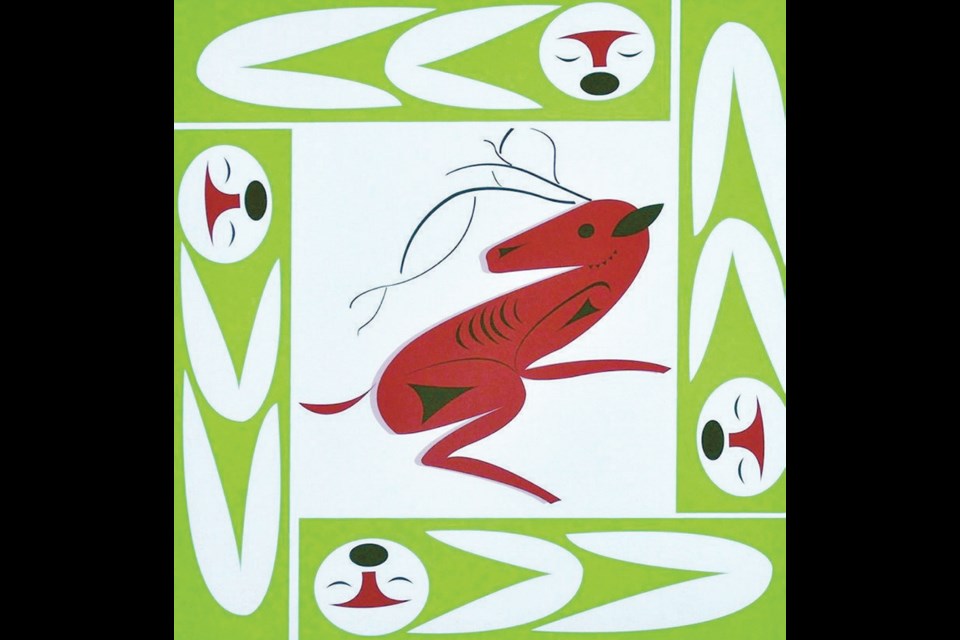 In the past few years, Salish art has come from the shadows to take its place alongside the better-known artistic traditions of this coast.
In the past few years, Salish art has come from the shadows to take its place alongside the better-known artistic traditions of this coast.
Historic Salish pieces are not as grand or as plentiful as those of the Haida, the Kwakwa’wakw or the Nuu-chah-nulth people, but the young contemporaries from our southern region are creative and vital. The current show at the Legacy Gallery features some of the best: Susan Point, lessLIE, Maynard Johnny Jr., Chris Paul, Dylan Thomas and John Marston. Curated by lessLIE, the show is drawn from a remarkable, and evolving, collection called Salish Weave.
Salish Weave, after which this collection is named, is a sculpture by Point, a Musqueam artist. It is made of nine thin planks of red and yellow cedar, carved and simply woven together. Point is best known for her large and colourful screen prints, though her practice also includes etched glass, cast concrete, bronze and much else. It was the prints that first attracted George Smyth and his wife, Christiane Leclerc Smyth, to Coast Salish art.
The Smyths arrived from Ottawa in 2000 and bought Point’s prints to decorate their condo in Victoria. They bought a few other First Nations items, but early on decided to focus their attention on Salish art, a new and wide-open field. At that point, many Salish carvers and printmakers, such as Charles Elliott, Cicero August and Doug Lafortune, “imported” elements from more northern neighbours. Saba’adeb, a major exhibit from the Seattle Art Museum (and seen here at the Royal B.C. Museum in 2009), established the history and parameters of the historic Salish graphic idiom.
Its elements are few and simple — circle, trigon, crescent — but these can speak volumes. Over the years, the Smyths expanded their collection to include sculpture, furniture, paintings, masks and many other forms of Salish art, and in the process befriended the leading young artists.
With these friendships came numerous commissions and with the Smyths’ encouragement the artists went on to bigger and bolder projects. The Salish Weave Collection has now grown beyond something personal to become a resource of great value to the Salish artists, and to our community. The Smyths have become “activist collectors.”
In 2011, the Art Gallery of Greater Victoria gave over an entire room to the Salish Weave Collection. The extraordinary ConunDrum by lessLIE was later an important part of a contemporary First Nations show there, called Transformers. Marston’s extraordinary carved and pierced panel, inspired by his trip to Papua New Guinea, is on loan to the Museum of Anthropology in Vancouver. Major shows at the McMichael Canadian Collection in Kleinberg, Ont., the National Gallery of Canada and other locations have drawn from the Salish Weave Collection, as it becomes known as the central repository for the finest of the new work.
The Smyths feel a serious responsibility as stewards of this work, and they believe it will help introduce all of us to the value of the indigenous culture of the place we live — Salish land, in fact. Since the best way to educate people is to begin with the young, they have commissioned prints that can carry the message. They are now completing their third boxed set: nine prints per box, 50 copies per print, by nine different artists.
The goal is to place these sets with each school board on traditional Salish land, as an inestimable resource.
As their collection outgrew their ability to house it, the Smyths arranged long-term loans of strategic value. The University of Victoria’s art collection happily received major works and has established the Cornett Building as a dedicated display space for more than 20 large originals. For this installation, Paul has created a brilliant wood and glass panel that addresses the balance of nature on campus, incorporating deer and rabbits. Vinyl panels designed by lessLIE adorn glass doors there.
The Smyths and Salish Weave have also established a series of courses to be taught at UVic by the anthropology department. Prof. Andrea Walsh recently gave a course based on Cowichan knitting. Students cleaned and carded wool, spun and knit patterned squares and created a large blanket. Lest anyone think it was an easy elective, the course considered the economics of knitting, met with and were trained by professional knitters and used Sylvia Olson’s book on the subject as their text.
As the collection, its intentions and goals continue to grow, Salish Weave is concerned with its “succession plan.” It is already a bigger responsibility than UVic can manage and connections have deepened with the Museum of Anthropology at UBC and elsewhere. Managing the active lives of these artworks has become a full-time job for Christiane Leclerc Smyth. And when the artists approach the Smyths with new ideas, they often find the support that encourages them to go ever further with their art.
Currently, the University of Victoria’s Legacy Gallery has on show 27 of the finest works in the collection. That gallery has never looked so elegant, spaciously hung with large wall-mounted sculptures and paintings by Point, lessLIE, Paul, Marston, Johnny and Thomas. Each artwork is beautifully crafted, thoughtfully designed and fully engaged with life and times on this Salish land. A careful study of the Salish Weave Collection will be a helpful thing for us all.
Perpetual Salish: Contemporary Coast Salish Art from the Salish Weave Collection, at the Legacy Art Gallery, 630 Yates St., 250-721-6562, Open Wednesday to Saturday, 10 a.m. to 4 p.m., until Jan. 10, 2015.
